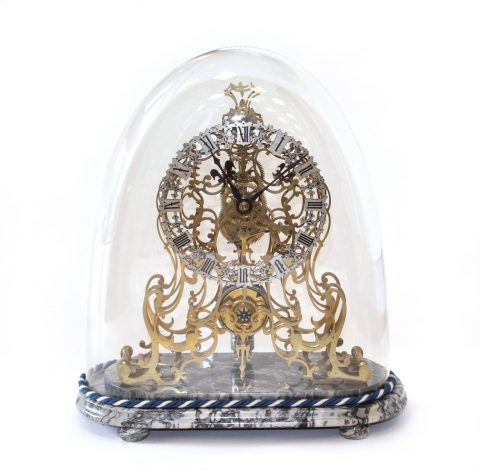English Arabesque skeleton clock, Evans of Handsworth

A finely made arabesque-frame skeleton timepiece dating from c.1870.
The elaborately scrolled polished brass frames are united by seven turned pillars. Unusually, this design has a third frame supporting the dial.
The single chain fusee movement has an 8-day duration with anchor escapement, with six-spoke wheel work throughout. The clock has a wooden rod pendulum with zinc cylinder bob. This, together with the other indications of very fine quality of craftsmanship point us to Evans of Holdsworth as the maker. The clock is unsigned, as was about 95% of Evans’ output.
The silvered pierced chapter ring has black Roman numerals with very bold black steel fleur-de-lys hands, which make telling the time by this skeleton clock rather easier than most.
The clock is mounted on a tiered oval veined marble base and is protected by a glass dome.
- Height 18″ (46cms)
- Width 16½” (42cms)
- Depth 7½” (19cms)
The Evans of Handsworth (West Midlands) factory produced many fine skeleton clocks including the Scott memorial and the York and Westminster Abbey models. William Frederick Evans (born 1819), joined John Houghton in his business The Soho Clock factory, and when Houghton retired in 1843 Evans took over the running of the business. He died in 1899 by which time his son, also William Frederick (born 1849), took control until his death in 1904.
The identical clock features on page 57 of Skeleton Clocks Britain 1800-1914, by Derek Roberts. There it is described as ‘..one of the most graceful [skeleton clocks] ever produced..’.
To be overhauled and guaranteed for 3 years.